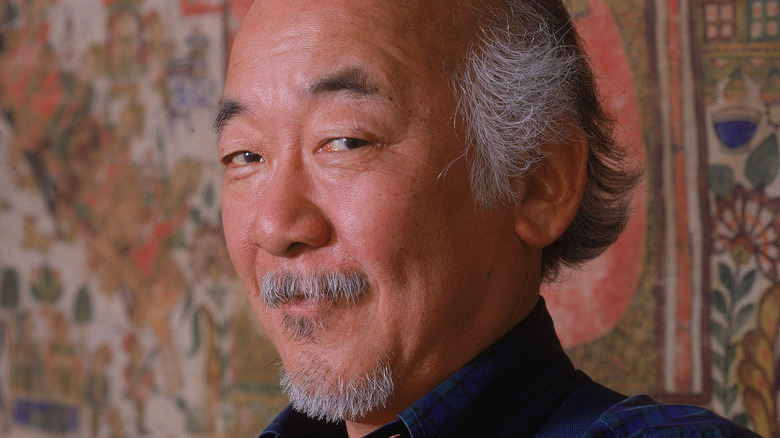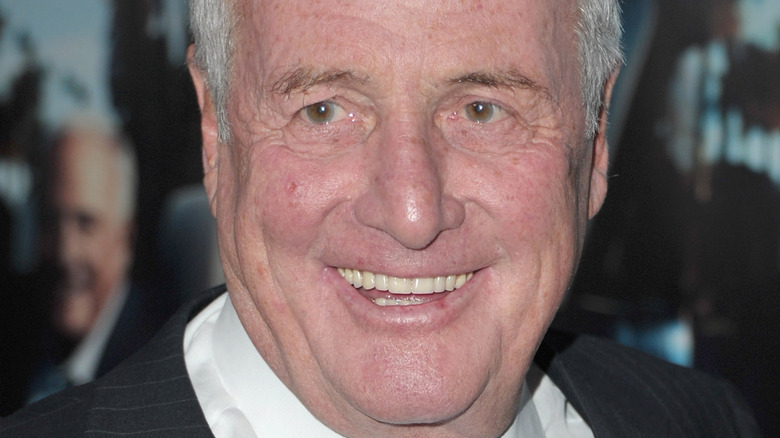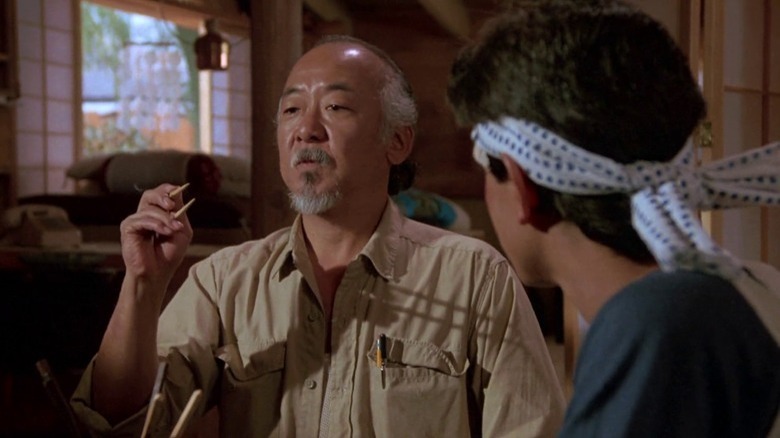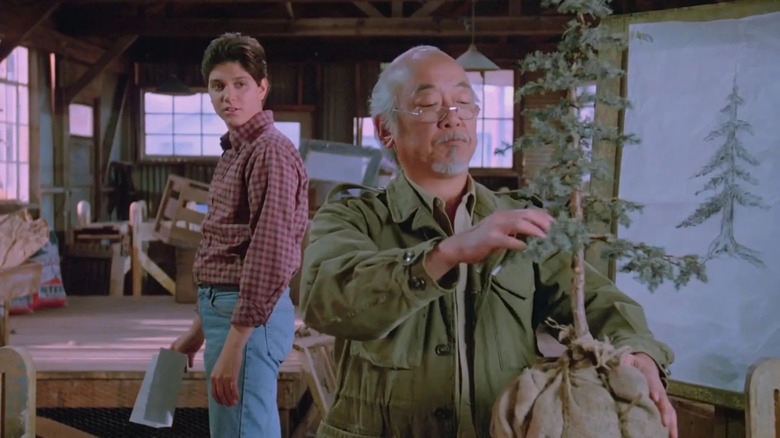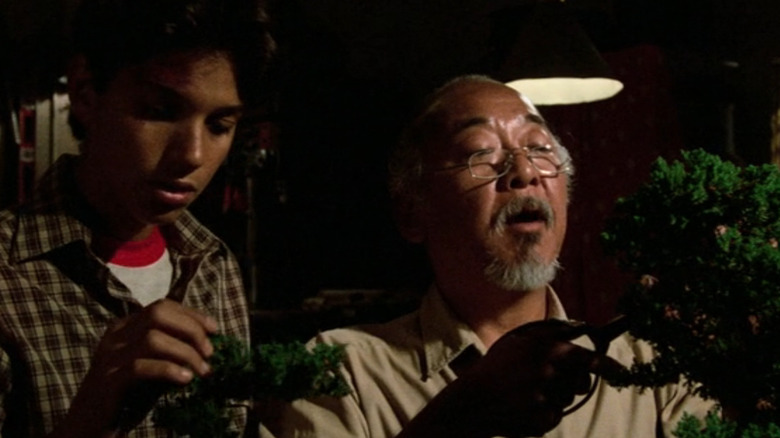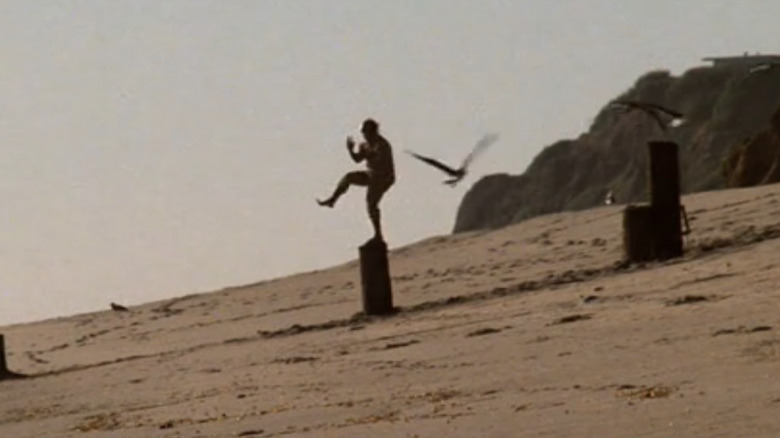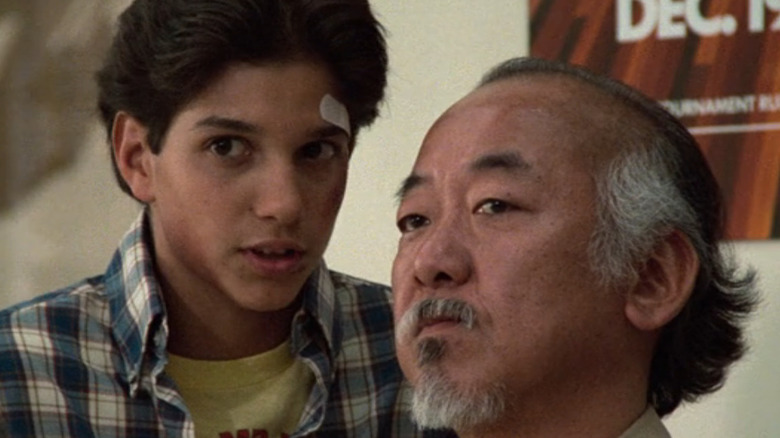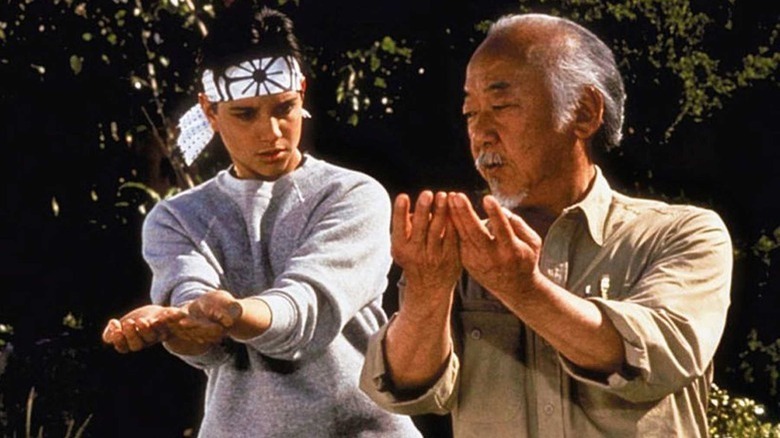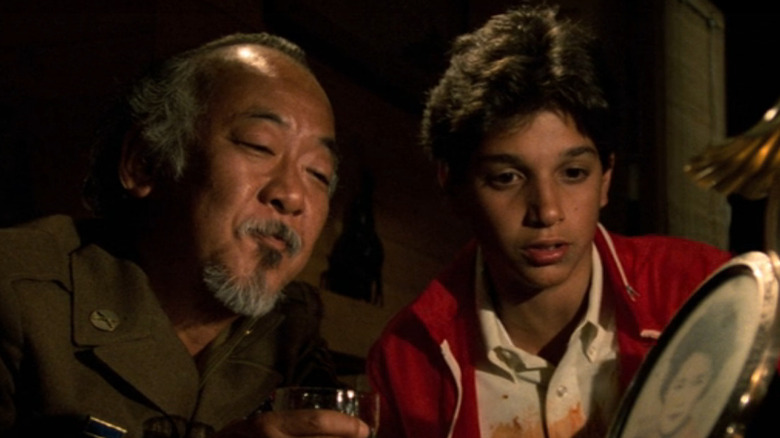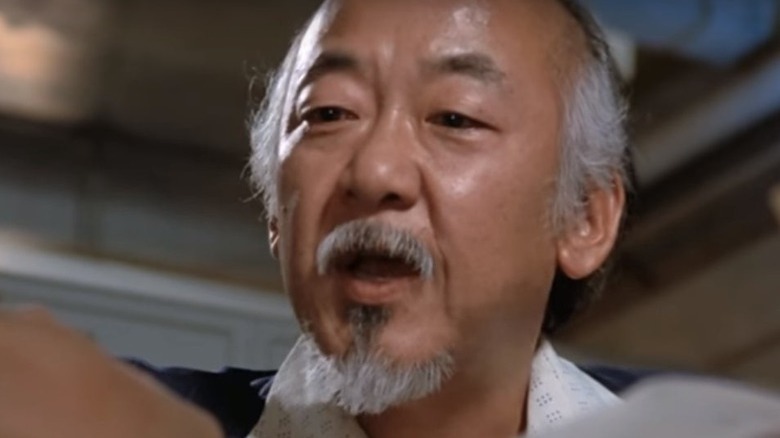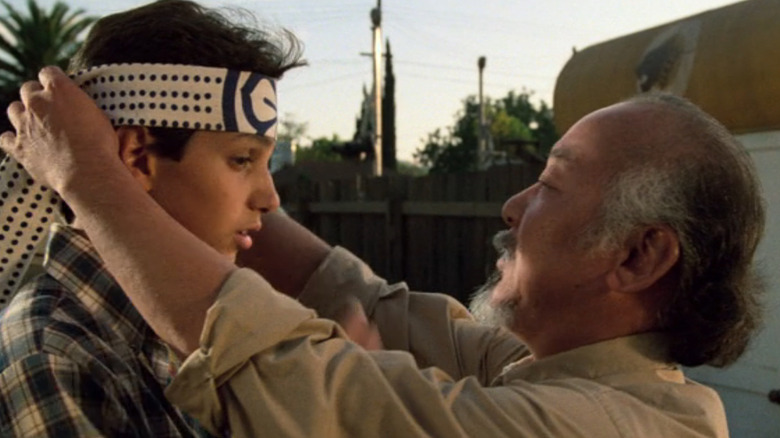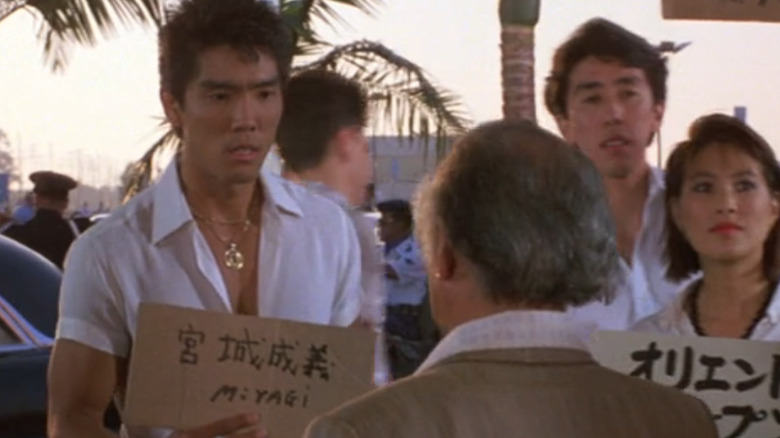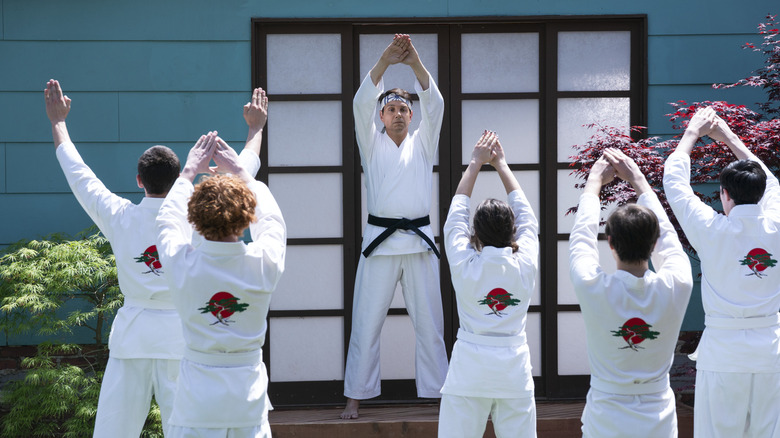The Untold Truth Of Mr. Miyagi From The Karate Kid
The 1984 coming-of-age classic "The Karate Kid" follows teenager Daniel LaRusso (Ralph Macchio) as he moves across the country with his mother and tries to adapt to a California social landscape where he doesn't fully understand the rules. He falls for classmate Ali (Elisabeth Shue), subsequently making an enemy of her ex-boyfriend Johnny Lawrence (William Zabka) and drawing the ire of the villainous Cobra Kai dojo. Fortunately, Daniel finds a martial arts mentor of his own in the form Mr. Miyagi, a soft-spoken Japanese handyman who just so happens to be highly skilled in the art of karate. The heartwarming tale went on to spawn multiple follow-up films, a quasi-remake, an animated series, and the massively popular live-action sequel show "Cobra Kai".
Played by Noriyuki 'Pat' Morita, Mr. Miyagi is one of the most iconic characters in the history of cinema. He gave a generation of kids a big-screen father figure who, by way of Daniel-san, offered wisdom on finding inner strength and staying balanced on the side of good. Here are some things you might not know about Mr. Miyagi that helped give him such an unforgettable presence on screen.
Producer Jerry Weintraub didn't want Pat Morita at first
Pat Morita started his career in the early 1960s as a comedic actor. When it came time to audition for the role of Mr. Miyagi in "The Karate Kid," he was known best for playing Arnold on the retro TV series "Happy Days," as well as for his stand-up comedy and numerous appearances on sitcoms like "M*A*S*H" and "Sanford and Son." As a result, "The Karate Kid" producer Jerry Weintraub" didn't think Morita had the chops to pull off the wise sensei. "Jerry Weintraub didn't want me for this. He wouldn't even consider me for a reading," Morita said in an interview with the Television Academy Foundation in 2000. "He was adamant, he says, 'I don't want a comedian, I don't want a comic actor for this role. This is a heavyweight part, I want an actor.'"
According to Morita, director John Avildsen had faith that Morita would be great in the role, so he called him in to read for it. Avildsen recorded the script reading with Morita by himself and encouraged the actor to hold onto the script afterward, telling him he might need it later. "That's the first teeny, teeny, tiny glimpse that maybe I got a shot at something here," Morita told the Television Academy Foundation. Avildsen then played the tape for an unsuspecting Weintraub, who was impressed but still required more convincing. Morita was brought in five more times in order to prove he was, in fact, the best choice for the part.
What's in a name?
When Pat Morita, born Noriyuki, decided to get serious about his acting career, he moved to Los Angeles and eventually got booked on the TV variety show "Hollywood Palace," prompting him to make a change. "I'd been Nori Morita through high school, then I changed to Pat," Morita told the LA Times in 1986. "In show business it sounded right. Comedians are Pat: Pat Henry, Pat Buttram. Not Harold, for example. Harolds go into weather." He kept the stage name for years until he was urged to go back to his roots.
Once producer Jerry Weintraub felt convinced that Morita was the Mr. Miyagi they were looking for, there was one more thing he felt could be done better. In an appearance on the David Letterman Show, the actor recalled Weintraub wanting a "real Japanese guy" to play the part. Morita offered to be credited with his birth name of "Noriyuki" if that would make him seem "more Japanese." There are only a few projects throughout the actor's career where he's credited as Noriyuki, but the studio did end up using his birth name for "The Karate Kid."
The real-life Mr. Miyagi
Many great films take inspiration from real-life occurrences. "The Karate Kid" itself is partially based on a true story, and several of the main characters are inspired by real people as well. The idea for the film came about when producer Jerry Weintraub saw a story on his local news channel about a young boy who took karate classes because he was being bullied. "As soon as the other kids in school found out that he was doing karate, nobody bothered him again," Weintraub told LA Weekly. "It was the real karate kid."
Weintraub gave the idea to screenwriter Robert Mark Kamen, who'd trained in martial arts for much of his life. Kamen was able to draw on his personal experiences, as well as honoring a couple of karate legends. Per a San Francisco Gate interview with Kamen, legendary teacher and practitioner Meitoku Yagi served as the primary inspiration for Mr. Miyagi. Meitoku Yagi himself studied under an Okinawan master named Chōjun Miyagi, who founded the Gōjū-ryū school of karate that serves as the basis for Mr. Miyagi's own style.
Mr. Miyagi's persona emerged naturally
One of Mr. Miyagi's most memorable traits in "The Karate Kid" is his particular, deliberate way of speaking, which is nothing like Pat Morita's real-life voice. In "The Way of the Karate Kid," a featurette with interviews from the cast and crew, Morita recalled how he naturally discovered the specific Mr. Miyagi persona without really thinking about it. "I don't know how, I don't know where it came from," Morita said, quickly taking on his character's affectations. "Miyagi voice, Miyagi presence, Miyagi spirit ... emerged." Even though director John G. Avildsen loved it, Morita was flummoxed after his first reading as to where the voice and mannerisms had come from. Mr. Miyagi was always meant to be lovable and slightly humorous, but Morita brought a whole new, unscripted element to the role.
The actor also found inspiration in his stunt double, Fumio Demura (per The Daily Beast). The 1961 All-Japan Karate champ, Demura had already made a name for himself in the movie industry, and the pair worked so closely together that they formed a lasting friendship.
Pat Morita never did the crane kick
When talking about "The Karate Kid", it's almost impossible not to think of the crane kick — the iconic move taught to Daniel by Mr. Miyagi. It ends up being the (kind of illegal) move that wins Daniel the championship at the All-Valley Tournament. If you are a fan of the film, you've likely even tried the kick at least once.
Stunt coordinator Darryl Vidal, who appears in the film, is the one given credit for making the crane kick so iconic. The kick is an actual martial arts move, but Vidal added the crane wing arm flourishes. Stuntman Fumio Demura worked as Pat Morita's stunt double for the majority of the film, doing it all except for the famous crane kick on the stump at the beach. That shot's all Vidal. In an interview on Waste Some Time with Johnny Greene, Vidal explained that he was chosen to be in the film for his martial arts kicks and jumps. It only made sense that as the creator of the crane kick, he would be the one to perform it on the stump for the cameras. The move was deemed too dangerous for Morita to even attempt. For years, this would make Vidal what he calls "the most famous person that no one knows."
Pat Morita had to train to be a sensei
Luckily, when casting for "The Karate Kid", it seems that the production team put acting ability and on-screen chemistry above all else. The main cast members earned their roles with their acting talents, not their karate skills. But of course, the film needed to look authentic, so the actors were given karate training. They can all thank karate instructor Pat E. Johnson for getting them up to speed.
"Ralph [Macchio] and Pat [Morita], they were my buddies," Johnson told Black Belt Magazine in 2020. "I trained both of them until they were unable to move, and they would share their aches and pains like two little old men and they built camaraderie through the training." Johnson understood the importance of the relationship between Daniel and Mr. Miyagi. He made sure to nurture that bond in training, and fans of the film will surely agree that it paid off.
The history of Miyago-Do Karate
When Mr. Miyagi agrees to train Daniel to defend himself in "The Karate Kid," the young man isn't fully aware of what he's getting into. On day one, Mr. Miyagi tasks Daniel with washing and waxing his vast collection of classic automobiles. The lessons continue with other chores such as hand-sanding the deck, painting the house, and painting the fence — both sides! Mr. Miyagi gives specific instructions on how each job is to be done, and unbeknownst to Daniel, he's being taught karate through muscle memory. Also, Mr. Miyagi finally gets that to-do list taken care of.
Fans of the franchise have come to know this style of martial arts as Miyagi-Do. Though this ancient style, passed down through Mr. Miyagi's family for years, doesn't exist in the real world, it serves Daniel well for three films. We learn more about where the Miyagi family karate comes from in "The Karate Kid Part II," when Daniel accompanies Mr. Miyagi back to his home village in Okinawa to say goodbye to his dying father.
In real life, Miyagi-Do mostly resembles the karate style of Goju-Ryu, roughly translated as "hard-soft." Dr. Hermann Bayer, an expert on Okinawan Karate, told Den of Geek in 2021 that "Karate legend Miyagi Chojun gave the name 'hard-soft' to the style in the mid-1930s." The balance of sturdiness and softness present in the style fits well with Mr. Miyagi's own philosophies on balance.
There was a fight to keep Mr Miyagi's big scene
There's a heartbreaking scene in "The Karate Kid" where Mr. Miyagi becomes truly vulnerable. Daniel arrives to find him drunk dressed in his Army uniform in front of a photo of his late wife. At first, Daniel thinks this is a celebration. As the scene and the drinking go on, however, it becomes more apparent that this is a dark time for Mr. Miyagi. As he recalls getting the news that his wife died due to complications in childbirth, many layers get pulled back. On this anniversary, Mr. Miyagi allows himself to dig into his grief over the loss of his wife and unborn son — events that happened while he was away serving in World War II. Surprisingly, the scene was almost cut.
Pat Morita delivers a heartbreaking performance that gives a glimpse of Mr. Miyagi's larger life. In the "Way of the Karate Kid" featurette, director John Avildsen discusses having to fight for the scene, which he believes played a big role in Morita getting the Oscar nod for Best Supporting Actor in 1985. Studio executives thought the scene was too slow, however. In the featurette, Morita calls the scene "the only real moment of Miyagi's fallibility and being human." Everyone else fully believed the scene should stay, and multiple people in the production lobbied hard for it. In 2019, Ralph Macchio told Vanity Fair how the scene was kept alive. "The studio and the editor wanted that scene cut. But they were wrong, and once they tested it, they shut up."
Pat Morita gave Mr. Miyagi extra depth
In 1986, Pat Morita told the LA Times that he based some of Mr. Miyagi's tragedy on his own life. When Morita was 2 years old, he suffered from spinal tuberculosis, spending nine years in a sanitarium near Sacramento. The disease caused him to spend most of his childhood bed-ridden and in a body cast. "One day," Morita told the LA Times, "I was an invalid. The next day I was Public Enemy No. 1, being escorted to an internment camp." Undoubtedly, Morita was able to pull from his real-life experiences in order to create the pain Mr. Miyagi feels.
Morita also suggested the song that Mr. Miyagi sings while grieving the loss of his family. It's a Japanese song that Morita heard during his time in the internment camps, but Mr. Miyagi calls it "Japanese Blues." Morita apparently also suggested the detail of Mr. Miyagi being a 442nd Army veteran who received the Congressional Medal of Honor — something the actor saw as a dark shadow on Mr. Miyagi's spirit. "Why had he survived the horrors of battle while his wife and child died?" Morita explained in an interview with Furyo: The Budo Journal.
Pat Morita supplied the headband
If you were to dress up as Daniel LaRusso for Halloween, your costume wouldn't be complete without his iconic headband. From the moment Mr. Miyagi gives it to Daniel, it symbolizes something significant for the boy, staying with Daniel through the film franchise and even returning in "Cobra Kai." Though it's nearly as iconic as the crane kick, the headband wasn't part of the original screenplay.
In an episode of "Where Are They Now?" on OWN, Ralph Macchio gives a tour of some of the "Karate Kid" memorabilia he was lucky enough to keep after filming. He proudly shows off the headband, explaining how it came to be so significant in the film. "Pat Morita had this as a handkerchief in his pocket," Macchio explains, "and he just took it out, you know, to pat his brow. And so then he just decided to put it on me, but it was never in the script."
What's Mr. Miyagi's first name?
There have been some inconsistencies throughout the "Karate Kid" franchise as to what Mr. Miyagi's actual first name is. In "The Karate Kid," Mr. Miyagi gives Daniel one of his cars as a birthday gift. The keys for the car are attached to a set of dog tags, which have the name "Hideo Miyagi" written on them. In "The Karate Kid Part II," Chozen Toguchi (Yuji Okumoto) comes to the airport to pick up Mr. Miyagi and Daniel, holding a sign with Japanese characters and "Miyagi" written in English. The Japanese name translates to "Nariyoshi." In "The Next Karate Kid," however, he's referred to as "Keisuke".
The mystery of the character's name is finally solved in Season 1 of "Cobra Kai." Mr. Miyagi is dead in the series, as Morita had already passed before it came about. In one scene, Daniel visits his old mentor's grave, which confirms that his name was indeed Nariyoshi. Fans can now file that away as the canonical answer.
Mr. Miyagi's spirit lives on in Cobra Kai
In 2005, Hollywood lost the memorable icon that was Pat Morita to kidney failure, after years of grappling with alcoholism. Along with his family, many close friends — including Ralph Macchio — mourned his passing. Even after the cameras stopped rolling, Macchio and Morita shared a special friendship that lasted for years (per ABC News).
Decades after the release of "The Karate Kid," the franchise's story has continued through "Cobra Kai." The series follows Daniel LaRusso and Johnny Lawrence in their adult lives, complete with kids, jobs, and long-held grudges. The series isn't just a tired reboot either, as new rivals and allies are born from the re-emergence of the Cobra Kai and Miyagi-Do dojos.
With most of the key players returning, Morita's absence is noticeable. Macchio was instrumental in making sure that Miyagi and Morita's legacy was honored in the show. Feeling imbalanced in Season 1, Daniel visits Mr. Miyagi's grave in search of guidance. "It was really important to me to have that in the show," Macchio told ABC News. There are small reminders of Mr. Miyagi throughout Daniel's life — bonsai trees, a serene dojo, his love of cars — that show how close Mr. Miyagi always is to his heart. In Season 3, Daniel even travels to Okinawa to learn more about his old mentor's life.
